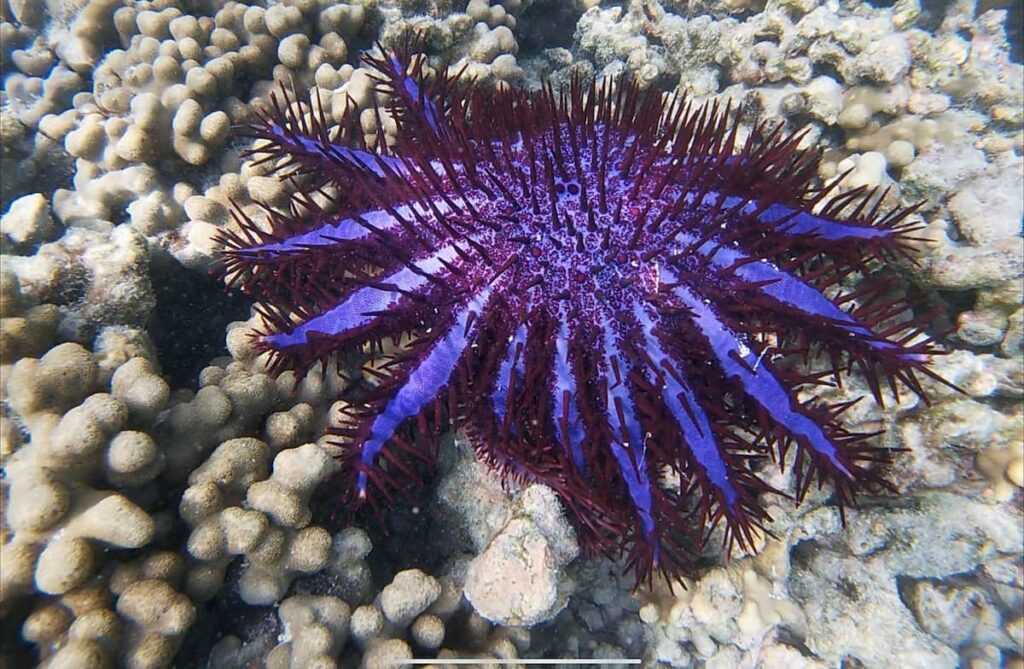Meet the Crown-of-Thorns Starfish
These venomous alien-like creatures are coral reef predators

Mesmerizing crowns. Gorgeous colors. Alien-like appearances beneath our ocean’s surface. There’s no doubt about it that crown-of-thorns starfish are fascinating animals. But don’t be fooled by the beautiful hues and interesting spikes … too many of these animals in one place can be destructive to coral reefs and dangerous to both humans and marine wildlife.
NOTE: Since they aren’t actually fish, scientists prefer people call animals of this type “sea stars” instead of “starfish.”But for the purpose of this blog (and the fact that it’s in their name), we’ll be referring to them as “crown-of-thorns starfish.”
Get Ocean Updates in Your Inbox
Sign up with your email and never miss an update.
Native to coral reefs across the Indo-Pacific region and Great Barrier Reef, crown-of-thorns starfish are disc-shaped and have around 21 arms, all of which are covered in venomous spikes that are one inch or longer. They can grow to more than two feet and are brightly colored in shades of blue, purple, pink and red. Despite their size and vivid coloring, crown-of-thorns starfish can be difficult to find as they often take cover in various nooks and crannies. Contrary to their hard appearance, crown-of-thorns starfish are flexible and able to contour and twist their bodies to move around and fit into various areas.
Crown-of-thorns starfish consume coral by extending their stomachs away from their bodies, enveloping the corals with their stomachs and digesting the tissue. These animals can be an important part of the ecosystem when thriving in “normal” numbers as they focus on consuming the faster-growing coral while allowing the slower-growing coral a chance to thrive. Sadly, crown-of-thorns starfish become a serious problem for coral reefs when there is an “outbreak”—when 15 or more crown-of-thorns starfish are found in one hectare area, or 10,000 square meters. During an outbreak, crown-of-thorns starfish can strip a reef of nearly 90% of living coral tissue, causing irreparable damage.

Because they are difficult to kill and can regenerate themselves in a few short weeks, controlling the number of crown-of-thorns starfish is incredibly arduous. Following an outbreak, trained divers will inject crown-of-thorns starfish with a vinegar or bile salt solution in multiple spots, and within a few days, the crown-of-thorns starfish will die without inflicting harm on surrounding marine life or ecosystems.
There are a few predators in our ocean that are not impacted by the venom and can take on adult crown-of-thorns starfish: giant triton snails, titan triggerfish, starry pufferfish and humphead maori wrasse. However, due to overfishing of their main predator, giant triton snails, the crown-of-thorns starfish population has expanded exponentially.
Additionally, reproduction can happen at an astounding rate—a female can produce more than 60,000 eggs during her spawning season throughout the summer months, and large females can release more than 200 million eggs annually. Dead corals provide a habitat for juveniles to grow and live as they camp out in the reef and feast on algae as they grow.Our ocean’s coral reefs are not only in considerable danger due to crown-of-thorns starfish, but they’re experiencing unprecedented threats from marine heatwaves due to the climate crisis. Take action with Ocean Conservancy today to protect these lifelines of the sea before it’s too late